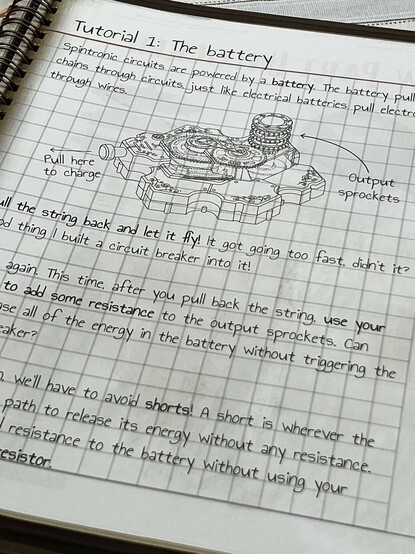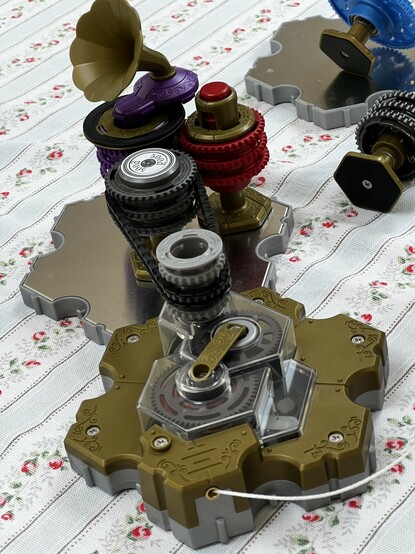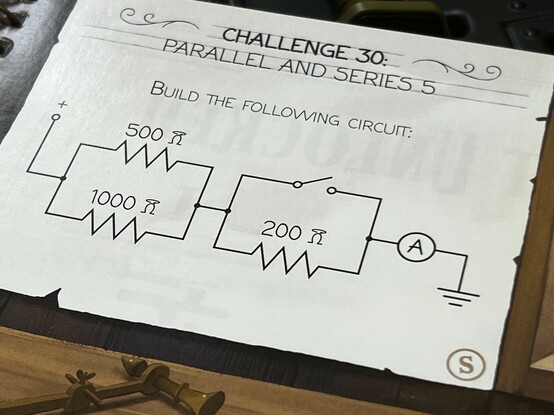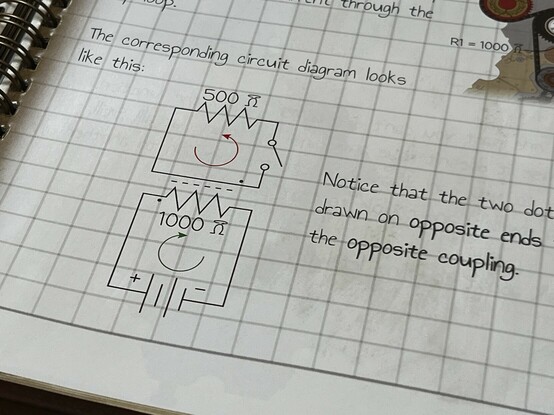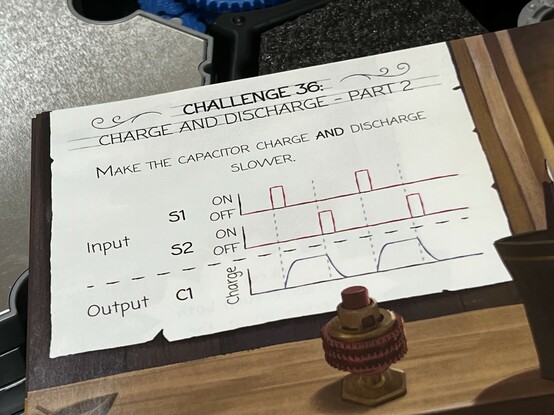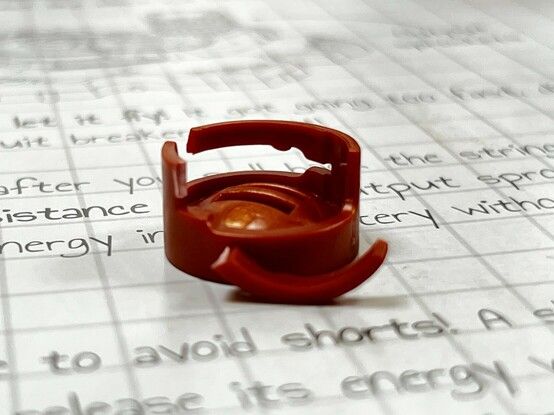Upper Story Spintronics – Act One – Reviewed
The inscrutable nature of electronics has led to myriad attempts to find the perfect analogy for the relationship between resistance, voltage and current. Water is the classic example, it can flow in a continuous circuit, be under various levels of pressure and be restricted by narrow valves. But water has the rather unfortunate side-effect of not translating well to a real-world, physical example. When your equivalent for an electrical arc is a jet of water across the room… parents might be a little reluctant.
Spintronics! It’s a beautiful, Babbage-esque, lavishly Steampunk, impeccably presented analog for analog circuits. It’s hands on in a way that volts either can’t or shouldn’t be 🤣
Enter Spintronics, a puzzle-game style introduction to the concept of electronic circuits that uses mechanical work – transmitted via gears and chains – as a stand-in for electric current. The very same principle, more or less, that enabled early computational devices like the Babbage Difference Engine to perform calculations before electronic calculators existed.
Spintronics leans into its early computing similarities with a steampunk aesthetic, captured both in the design of the puzzle and its accompanying book. The narrative places the device, its creator, and the various challenges you must overcome into an alternate history. It’s set in a universe where clockmakers can stretch time at will to make more out of the day. Though this has no real bearing on the narrative, it’s a distressingly perfect metaphor for hyperfocus. You follow the story of a young, child prodigy of artisan clockmakers – Natalia. She sets about exploring the world of mechanical circuits to save her parents from a life of tireless hard work; time-stretching themselves to exhaustion in order to get by.
Familiar concepts to electronics are realised as mechanical contrivances. Gears and chains allow you to divide and join work as if they were wires. Chains form a continuous loop and – like an electronic circuit – must do so to function. Resistors take the shape of oil-filled, hard-to-turn gears and – again like in a real circuit – it doesn’t matter if they are before or after your “load”. Switches are gears with a push-button break. A crude, tiny gramophone acts as a sounder and ammeter. A spring-loaded gear assembly serves as a capacitor.
Everything is packed neatly into the box. It almost venerates each component, and 4yo has too much fun taking it out and putting it away 🤣
Everything is powered by a spring-loaded battery. The battery is “charged” via a pull-cord that winds up the spring. Unloaded, or “shorted” it will discharge rapidly, stopped only via a centrifugal break. Adding a resistor will slow the discharge to a more manageable rate. This is easily one of the quickest and most profound lessons Spintronics will teach you about electronics- if you don’t restrict the flow of current, bad things will happen. In the case of this mechanical analog, however, “bad things” does not include fingerprint-zapping heat and spontaneous puffs of black “magic” smoke. That’s not to say the sudden discharge of the Spintronics battery isn’t spicy. It’s loud, dramatic and every bit the fitting stand-in for wanton component destruction- X even managed to get a long chain to explode.
A spring-loaded mechanical battery for mechanical circuits is rather an ingenious idea. Unloaded it will wind down rather dramatically and engage a centrifugal break- rather like battery short protection!
The various Spintronics components include magnetic bases which allow them to clamp free-form onto a matrix of hexagonal, metal base plates. You are free to configure the shape of the three supplied base plates – connecting them together with plastic joiners and a cute key – and free to place components more or less as you see fit. This freedom tends to result in a fair bit of optimisation and tweaking when you’re exploring and layout out a new design… but wha’d’ya know, that’s not entirely removed from the blank canvas you might start with as an electrical design engineer. While the specific problems of layout out a mechanical circuit don’t quite map onto those of an electronic one- though in either case, too long “wires” will do you a disservice- the concept of thinking about optimal component placement is very familiar. The lack of any mechanical connection between the parts and the base also makes it hard-wearing and gives one less mechanical interface to wear out.
The accompanying book is beautifully illustrated and lavishly detailed. It’s also spiral bound and really feels the part.
As you work through the book you’ll find various electronic concepts explained and be guided through the unique quirks of Spintronics that you’ll need to understand in order to make efficient, functional mechanisms. After covering the fundamentals, the book quickly introduces basic circuit diagrams and sees you translating the symbols into Spintronics components. You’ll even find signal diagrams showing “voltage” over time, as you might see when exploring a real circuit with an oscilloscope.
An early puzzle- involving clockwise and counter-clockwise rotation- ran up against my stubborn inattentiveness to the actual instructions and I eventually figured out I could cross a chain in a figure-eight: clearly not an intended solution, or one that works well, but it worked for me. Since Spintronics components are circular gears, the concept of reversing polarity cannot be expressed by putting them backwards. I eventually relented and looked up the solution. While only some specific puzzle solutions are documented in the back of the book, all of the solutions are available on Upper Story’s website. Turns out I really should have set up the puzzle as pictured rather than forging out with my own layout. Sometimes it’s a little too fun to venture off into unknown territory and experiment!
Am I doing this right?
Of course when asked to drive a component in reverse I find the one solution they didn’t see coming. Crossing the chain in a figure eight.
There’s a certain ebb and flow to the book that mirrors conventional puzzle design. Introduce a mechanic, explore its fundamental properties, build upon it and then challenge the user to apply those skills. In Spintronics each new mechanic takes the form of a new part- the resistor, the switch, the junction and so on. The story will build up to a motivation behind its creation, and a “New Part Unlocked” page will introduce the part with a detailed exploded diagram and describe its basic function.
Once Spintronics exhausts the fundamental principles of electronics that it embodies, the puzzles also begin to explore some concepts unique to this mechanical analog. You’ll work through understanding and diagramming these, and solve puzzles involving them. This strays away from a purely electrical understanding of the system, but offers a much wider scope for puzzles to stretch the playtime out further. Beyond the puzzles, the simple act of exploring the relationship between components and coming up with your own devices has some merit. And, beyond that? Spintronics has an Act Two with new parts and new puzzles! I’m very intrigued by the inductor and transistor.
There are lots of different concepts to explore, presented via familiar (albeit occasionally wildly different) schematics and diagrams.
By leveraging mechanical concepts to teach electronics ones the system fuels an interest in and understanding of both electronics and mechanics. It’s also interesting and tactile in a way that electronics components simply aren’t. Don’t get me wrong, there’s real joy in having a grab bag of components, some wires and a battery but you can’t simply physically twist a real resistor and feel its resistance, or feel the physical effects of “voltage drop” across a resistor.
Spintronics isn’t perfect. The little connectors joining the baseplates are fragile and we’ve already broken one. A few extra spares in the box or a more hard-wearing design would be appreciated! You can buy spare or additional parts at your leisure but the joiners are not available separately. I’m relatively sure Upper Story would throw a few in the post at the drop of a hat, though.
Fragile part is fragile!
The free form magnetic layout style may lead to a small point of frustration with Spintronics. Laying out devices on a smooth, metal surface can sometimes result in them slipping and sliding around as you build out other components. While this slip is necessary for hooking completed chains around components – a practice much easier than trying to join a loop of chain in place – it’s not always desired. It does, at least, enforce the “slightly slack chains are more efficient” reality of a chain driven system, and I’m entirely underselling the strength of the magnets here- it’s not like they slide often!
Chopping and changing chains, too, can be a little tedious but does provide a rather fitting parallel to the arduous task of cutting and stripping single-core wire in order to neatly lay out an electronic circuit on a breadboard. How far can we stretch a metaphor for the cathartic mindfulness of electronics tinkering before it breaks? I think it depends upon the temperament of the user, and you’ll know if you- or the person you might pick up Spintronics for- is the careful, patient type who would relish in its challenges.
That said, even a complete disregard for the book and a thirst to tinker with the individual parts has my four-year-old captivated for short, managed bursts. Too long and things get dicy, though!
A simple circuit with an on-off switch. Sometimes I can’t be bothered with chains, ok? 🤣
There’s also a distinct lack of real work being done by the Spintronics circuits, the Ammeter gramophone comes close to serving as a buzzer or sounder but otherwise it feels like analogs to things like LEDs, motors or displays have been overlooked. It’s fair to say that Spintronics circuits are compelling enough in their own right without really doing anything, but how awesome would a flip-digit counter be? Or a little fan. Or a dynamo-driven LED? There must be a steampunk mcguffin to explain away how light could be generated from mechanical work. Judging by the Act-based structure of the puzzles, I’d guess ideas like this are an Act 3 or Act 4 reveal. If these should intrigue you then you could always skip the intervening acts and buy the individual parts.
These very very minor complaints aside, Spintronics is a compelling and mindful puzzle that’s meticulously crafted and beautifully presented. It serves as a great introduction to circuits and their associated concepts, and even touches the very fundamentals of electrical design- from the care required to avoid catastrophic failure, to the mindfulness of circuit layout. You can pick it up for just shy of £80 direct from Upper Story’s store.
You can even buy all of the CAD files and puzzle book PDFs and build your own parts or design new ones. Perhaps this is my gateway to flip-digit counter nirvana?
If you’d like to get a feel for the system then Spintronics even have an online simulator which they use to offer puzzle solutions. You can even buy the individual puzzle books in PDF format and explore the whole game digitally for just £6!
This refreshingly open-source ethos backing up Spintronics is fitting for electronics- in the maker community as much joy is found in the act of sharing designs, instructions and code as there is in their creation. This openness, coupled with the attention to detail and care – some fragile parts aside – put into Spintronics more than justifies its price.
In conclusion I think it should be obvious at a glance that Spintronics would be something I’d love and, more so, recommend. Indeed, its visually compelling Steampunk allure drew me in and I’ll be glad to have this kit handy for when my boys are a little older. Now, Act 2 is calling me. I must dash!


